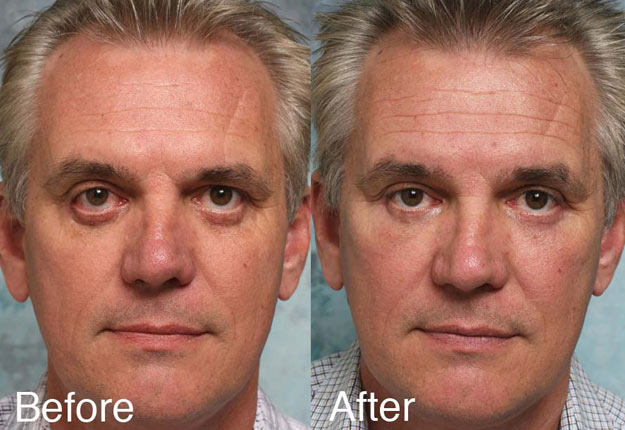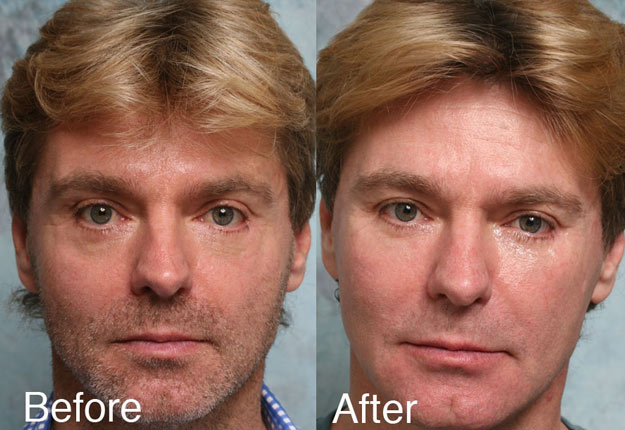Published on March 27, 2024 by Kenneth D. Steinsapir, M.D.

Post-blepharoplasty lower eyelid reconstruction is an essential service when cosmetic lower eyelid surgery does not go as planned. These same reconstructive methods are also helpful to address complications after cheek implant and midface surgery, orbital changes after thyroid eye disease, congential midface hypoplasia, and certain complex circumstances following trauma and skin cancer.

The most powerful and nuanced approach to this procedure has been developed by Dr. Kenneth Steinsapir, who utilizes hard palate grafts and hand-carved ePFTE (expanded porous flouro-polyethylene, what Gore tex is made from) orbital rim implants. This method, while less commonly discussed in general plastic surgery literature, offers unique advantages when compared to other approaches, such as those using ear cartilage, porcine, and dermis grafts. In this blog, we will explore Dr. Steinsapir’s technique in detail and compare it with these other methods to provide a comprehensive overview of lower eyelid reconstruction strategies.
Dr. Kenneth Steinsapir’s Method
First and foremost, Dr. Kenneth Steinsapir’s approach to lower eyelid reconstruction approach is not about the grafts or making the tightest possible lateral canthoplasty. It is about recruiting more skin and soft-tissue into the eyelid space. Above all else, these eyelids are short of tissue from excision and scaring from the original surgery(ies). Deep scaring in the eyelid from the original surgery tethers the lower eyelid to the cheek. This is the basis for the vertical and horizontal inadequacy that is typical of these eyelids. Simply tightening the compromised eyelid with lateral canthal surgery, even drill-hole canthoplasty, can’t provide the soft tissue elevation needed to restore the lower eyelid. A well-meaning surgeon might even tell you that you need a skin graft or a tarsorrhaphy, disfiguring surgery that puts an ugly skin graft in the middle of the face or sews the corner of the eyelids together. These are aesthetically unhelpful approaches.
The lower eyelid surgery that Dr. Steinsapir developed to address these pulled down lower eyelids permits a reconstruction without compromising the aesthetic outcome as you can see for yourself by studying his results. Dr. Steinsapir performs a vertical lift of the cheeks. This recruits skin and soft tissue into the eyelid space where it is missing. To make this permament, Dr. Steinsapir hand carves a custom ePTFE rim implant for you at the time of surgery to permanently hold the vertically lifted cheek. The ePTFE rim implant is fixed to the orbital rim with microscrews. The lifted cheek is then sewn to the top of the fixed rim implant. The implant provides volume but it is primarily functioning as a felting material creating a place to sew the lifted cheek.
The hard palate graft is meticulously shaped to fit behind the lower eyelid. This is crafted to provide long-term shaping to the lower eyelid margin. This is carefully sewn in place. This combination of support and shaping allows the lateral canthal angle to support the lower eyelid margin and permit the lateral canthal angles to be reconstructed without the type of tension that causes other approaches to fail.
The use of autologous (from the patient’s own body) materials minimizes the risk of adverse reactions and ensures a more natural integration with the existing tissues. Moreover, the precision involved in hand-carving the implants allows for a customized fit that can more accurately address the unique contours and needs of each patient’s facial structure.
Comparison with Other Methods
Ear Cartilage Grafts: Ear cartilage is another autologous material option for lower eyelid reconstruction. It is somewhat easier to harvest than the hard palate graft, but that is about the limit of its benefits. Harvesting cartilage from the ear can cause ear scarring. Also the cartilage becomes brittle over time meaning that it can break causing undesirable kinking in the eyelid, which is disfiguring. Due to its brittleness it is hard to shape meaning it is difficult to finesse its shape. It is rigid and can appear lumpy in the eyelid. As a practical matter ear cartilaginous grafts do not provide the same level of structural support as the hard palate, potentially limiting its use in cases requiring significant reconstruction.
Porcine Grafts: Porcine (pig) grafts offer an off-the-shelf solution for eyelid reconstruction by eliminating the need for a donor site on the patient’s body. While they are treated to be biocompatible and have been used successfully in many cases, there is a higher risk of rejection and infection compared to autologous materials. Additionally, some patients may have ethical or religious concerns regarding the use of animal tissues.
Dermis Grafts: Dermis grafts, taken from the patient’s own skin, provide another autologous material choice. They are especially useful for adding volume and improving the texture of the eyelid skin. However, dermis grafts may not offer the same level of structural support as hard palate or ear cartilage grafts, and their use may be limited to more superficial corrections. There is also a cadaveric dermis graft material (commercial example is Alloderm). This material is decelluarlized and irradiated. Effectively it is a scaffolding of human collagen. This has the advantage of being human collagen and there is wide clinical experience with this off-the-shelf product. However, this material is rapidly broken down and removed by the body and generally replaced with a more organized scar. The downside is that long term, the material is not present to make a structural difference.
Conclusion
Each of the described methods for lower eyelid reconstruction has its own set of advantages and considerations. Dr. Kenneth Steinsapir’s technique utilizing hard palate grafts and hand-carved orbital rim implants offers a highly customized, autologous solution that minimizes the risk of rejection and provides significant structural support and volume correction. In contrast, other methods such as ear cartilage, porcine, and dermis grafts present alternative options that may be preferred because they are less demanding of surgeon expertise, but often require a compromised in the outcome. For these reasons, Dr. Steinsapir does prefer the use of hard palate grafts due to their versatility, long term stability, and proven track record.
Are you ready to see Dr. Steinsapir to learn your best options for lower eyelid post-blepharoplasty reconstruction?
Call Dr. Steinsapir today to schedule your service.
About Dr. Steinsapir
Dr. Steinsapir is a board-certified eye surgeon and fellowship trained in oculoplastic surgery and cosmetic surgery in Los Angeles and Beverly Hills where he specializes in balanced facial cosmetic surgery for natural results, with an emphasis on minimally invasive techniques, fast recovery time, and leadership in medical technology. Dr. Steinsapir has a private practice in Beverly Hills and also serves as a volunteer faculty at the Jules Stein Eye Institute, David Geffen School of Medicine at UCLA. Contact us today to learn how Dr. Steinsapir’s can make a difference for you.

